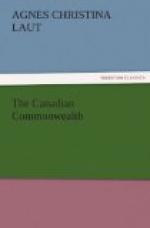In one section of the western prairie are 150,000 Galicians. Of Austrians and Germans—the Germans chiefly from Austria and Russia—there are 800,000 in Canada, or a population equal to the city of Montreal. Of Italians at last report there were fully 60,000 in Canada. In one era of seven years there took up permanent abode in Canada 121,000 Austrians, 50,000 Jews, 60,000 Italians, 60,000 Poles and Russians, 40,000 Scandinavians. When you consider that by actual count in the United States in 1900, 1,000 foreign-born immigrants had 612 children, compared to 1,000 Americans having 296 children, it is simply inconceivable but that this vast influx of alien life should not work tremendous and portentous changes in Canada’s life, as a similar influx has completely changed the face of some American institutions in twenty years. Immigration to Canada has jumped from 54,000 in 1851-1861 to 142,000 in 1881-1891, and to 2,000,000 in 1901-1911. It has not come in feeble rivulets that lost their identity in the main current—as in the United States up to 1840. It has come to Canada in inundating floods.
Chief mention has been made of the races from the south of Europe because the races from the north of Europe assimilate so quickly that their identity is lost. Of Scandinavians there are in Canada some fifty thousand; of Icelanders, easily twenty thousand; and so quickly do they merge with Canadian life that you forget they are foreigners. I was a child in Winnipeg when the first Icelanders arrived, and their rise has been a national epic. I do not believe the first few hundreds had fifty dollars among them. They slept under high board sidewalks for the first nights and erected tar-paper shanties on vacant lots the next day. In these they housed the first winter. Though we Winnipeggers did not realize it, it must have been a dreadful winter to them. Their clothing was of the scantest. Many were without underwear. They lived ten and twenty to a house. The men sawed wood at a dollar and a half a day. The women worked out at one dollar a day. In a few weeks each family had bought a cow and rudiments of winter clothes. By spring they had money to go out on their homesteads. During winter some of the grown men attended school to learn English. Teachers declared they never witnessed such swift mastery of learning. To-day the Icelanders are the most prosperous settlers in Manitoba. The same story could be told of German Mennonites driven from Russia by religious persecution and of Scandinavians driven abroad by poverty. Of course, the weak went to the wall and died, and didn’t whine about the dying, though some mother’s heart must have broken in silence. I recall one splendid young fellow who walked through every grade the public schools afforded, and then through the high school, and was on the point of graduating in medicine when he died from sheer mental and physical exhaustion. This type of settler will build up Canada’s national ideals. It is the other type that gives one pause.




